
 All Blacks 11 / 5 Springboks (Eden Park, Auckland 1 September 1956)
All Blacks 11 / 5 Springboks (Eden Park, Auckland 1 September 1956)
Ron Hemi:“The fourth test was the hardest game I ever played in, and this was at a time when I considered myself to be at peak physical fitness. South Africa made a big mistake in the selection of their first five-eighth and fullback. Bill Clark and Ross Brown were able to box in Howe and kill play close in, preventing the South African outside backs from operating. And a more determined fullback than Viviers would have prevented Jones’s try. The New Zealand tactics of bursting around the rucks, the ball being kept at close range in front of the forwards, was the winning formula.”
The story went that Peewee Howe was forced to change in the All Blacks’ dressing room after the game.“Personally I didn’t have a good”, said Howe bitterly, “and Basie Viviers made a few remarks to me afterwards. I replied that at least Peter Jones didn’t take the ball out of my hands and score a try”.
Basie Viviers:“The first of September 1956 is a day in my life I’d like to forget. I missed my kicks. That’s why we lost. Well! How do you feel when you lose? You don’t play to lose, do you? My tour was not successful.”
It was called the test of the century at the time. Tom Morrison, convenor of the New Zealand selection panel, felt it might be the toughest test match ever”. South Africa was defending its 60 year never-beaten-in-a-series record and New Zealand was playing to beat the only country they’ve never beaten in a series. There was more to it, however, for New Zealand; the whitewash of 1949 was to be revenged and the virtual rugby world title was up for grasps to crown it all.

The unofficial world rugby crown was at stake and New Zealand claimed it to be theirs, after the match, as can be seen in this cartoon.
The build-up to the match was intense, the crowd involvement before, during and after the game was almost riotously intense, the match itself warzone like intense and the finish sitcom drama intense when Tiny White was seemingly turned into a cripple by a vicious kick to his back. Then Craven topped the intensity of the moment with his short but poignant speech ‘It’s all your New Zealand’ just to be outdone by hero of the day Peter Jones with words that went across New Zealand with the intensity of runaway bushfire ‘I am absolutely buggered’.
It was a national ‘hysteria’ that was coming to a close after long and exhaustive preparations to combat the Springbok ‘invasion’.
It is doubtful that any band of traveling sportsmen in any code, or any country, has ever (before 1956 and thereafter) encountered an entire nation so determined to beat them, so united in a common, burning ambition to bring about their defeat as was a case of the 1956 Springboks in New Zealand. The official count was 61,240 spectators inside the ground and an estimated 5000 in the Scotsman’s stands. They greeted Danie Craven with a massive booing intermingled with a ‘sarcastic’ rendition of ‘Tell Me a Story, Tell Me a Story’ when he came out to test the surface.
It was panic stations when Craven went back and ordered the sprigs on the player’s boots to be changed to a smaller size. Three boot-makers -eventually found in a nearby hotel- told Mrs Craven to bugger off or they wouldn’t touch the boots when -down on her knees- she was trying to help (mucking around according to Terry McLean). The last sprigs were replaced 45 minutes before the match started.
Meanwhile Craven in what appeared to contain an element of panic was rejecting virtually every ball –one too hard, the other too soft- he was given to inspect.
Calmness, clarity and unity were certainly not characteristics of the Springbok camp in the run-up to this test match. The Springbok team was selected after two very long conferences. The first long discussion by the tour committee had been acrimonious even to the extent of somewhat bitter debate on the type of game they should employ. It was obvious what the All Blacks strategy was going to be and the two most important issues under discussion were; firstly, the style of game best calculated to hold New Zealand’s tremendous drive among the forwards; secondly, the backs and loose forwards most likely to create loopholes in the New Zealand defence.
What do you sacrifice in the pack; speed or weight, and what do you sacrifice in the backs; tactical astuteness or mercurial running ability? Those were the questions that confronted the selectors. The team that they came-up with was something of a compromise with regard to the forwards and a calculated risk with regard to the backs. In the pack Newton-Walker was included on the lock with Claassen. Starke and Du Rand were selected on the flank and Lochner at No 8. The frontrow was Bekker, van der Merwe and Koch. In the back Howe gained the vote over Ulyate as flyhalf on the strength of his great running the previous week against the Maori’s. Paul Johnstone was selected for his first test –after eight caps- as inside centre; the plan being that he and Howe should cut the line. Gentles was injured which opened the door for Strydom at scrumhalf. Nel came in on outside centre as Kirkpatrick had his nose fractured in the Maori game. Viviers was on fullback and Dryburg got the nod above Van Vollenhoven on the one wing with Briers on the other wing.

Bennett ‘Peewee’ Howe got the nod for the flyhalf berth based on his performance against the Maori’s the previous weekend.
When Koch withdrew the day before the match due to a back injury obtained during practice Newton-Walker was moved to prop and Du Rand back to lock. Retief returned to the team on flank. This gave the team three fast loose forwards but less bulk up front.

James Strake playing in the fourth test in 1956. He had a reasonable game. In the background from left to right is Jaap Bekker, Salty du Rand (partially obscured), Johan Claassen and Bertus van der Merwe.
The final team were: Basie Viviers (C); Theunis Briers; Jeremy Nel; Paul Johnstone; Roy Dryburg; Bennett Howe; Coenraad Strydom; Japie Bekker; Bertus van der Merwe; Henry Newton-Walker; Daan Retief; Salty du Rand; Johan Claassen; James Starke and Butch Lochner.
Years later Johan Claassen’s remark that “the first points were scored for New Zealand by our selectors” revealed what he thought about the team. “I don’t want to mention names,” he said, ‘but that was my genuine view of the team after it had been announced.”
New Zealand in contrast got their selections right and had clarity in how they were going to approach the match. They made only one change to their team. Ross Brown was moved from centre to flyhalf due to injury to Archer. Pat Walsh who played fullback in the first two test matches was included in the line-up as centre. The New Zealand team can be seen in the picture below.


Ross Brown in the third test. In the last test he was moved to flyhalf and played so well that he was nominated by some pundits as the best flyhalf of the series
Kevin Skinner on the game plan: “We knew the pattern they were going to play –the three loose forwards Lochner, Retief and Ackermann getting the ball to their five-eighths and for them to bring it back in. We decided on using Bill Clark on the open side. We were at the advantage right from the jump-off because Bill was putting Howe, ball and all, where we wanted him, so they couldn’t get away with it. If they used the backline more to spin the ball, the result could have been different, but we didn’t allow them to use their potential.”
The problem for South Africa was that they had no answer for the pressure applied by New Zealand. The Springboks won the scrum count 18-16 and the line-out count 30-22 and enjoyed territorial advantage for most of the first half. Despairingly, however -due to the pressure applied by the New Zealanders- it was poor quality ball which allowed the kiwis to box Howe in and keep the Springboks on the back foot.
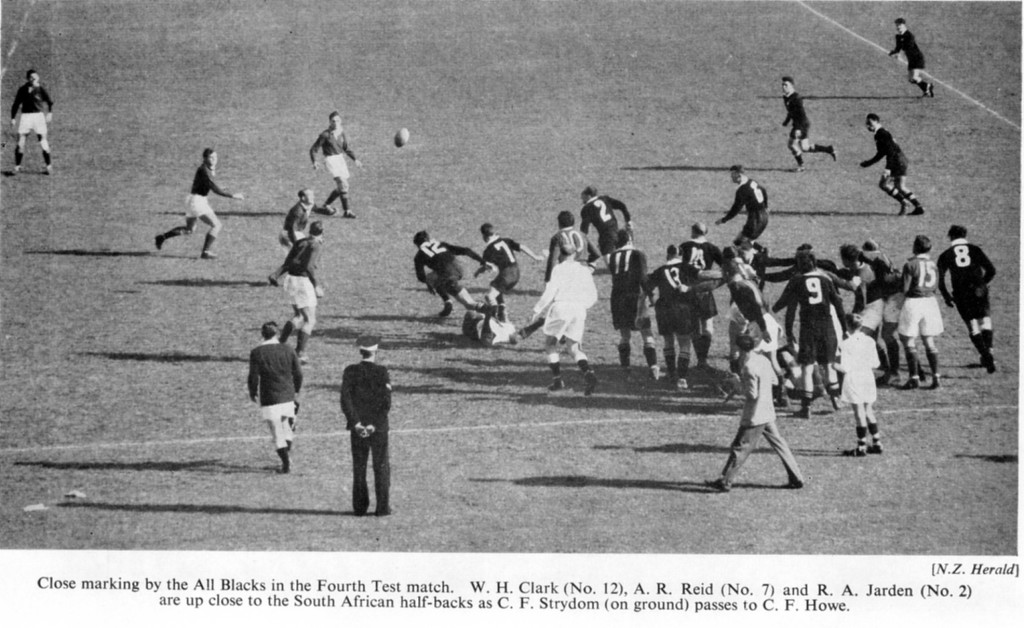
The All Blacks simply rushed through line-outs and scrums and applied sustained and immense pressure on the South African halfbacks
Their own set piece ball was a lot better controlled but they kept the ball close to the forwards working cohesively for the break-through with the ball at their feet or short-passing at close quarters, or utilizing the short box kick just over the heads of the backline or the up and under on the full back.
It was specifically their speed to the tackle ball and their structure and aggressiveness at the rucks that took the Springboks out of the game. They simply brushed the Springboks aside at the tackle ball like a tsunami on the rampage to the extent that Craven said after the match: “They were tougher and harder than we were.”

So cohesive and well-structured were the New Zealand set piece play that when they had to play with 7 forwards in the last 30-minutes of the match they held their own. In fact, they played for most of the match with 7 forwards in the tight loose as Bill Clark was instructed to roved freely in the loose play and as a result played well out from the lineouts to worry and Boks’ Bennett Howe
The New Zealand victory was brought about by two main factors. First the truly remarkable and sustained fire and drive of the of the forwards and the equally remarkable way the team as a whole rigidly adhered to the tactics laid down for them by the coaches.
The only relaxation from their game plan came in the dying stages of the match when Gray on his own goal line foolishly tried to open it up. He fumbled a pass in his attempt to get the counter attack going and in a flash Howe got the ball went for the outside break on the side line before in-passing to Dryburg who went on and scored.

In this picture Bill Gray is breaking out of Paul Johnstone’s desperate grasp. Moments later he fumbled a pass. The ball was scooped-up by Howe who sent it in-field to Dryburg, to score. In this match the ball hardly ever went to the All Black centres. It was not really wanted there in the New Zealand victory plan
South Africa had pinned great hopes on the elusive Howe but as well as being harried unmercifully by the New Zealand loose forwards; he came up against a brick wall in the defence of Brown and Gray. Six times he tried to break between them. Four times Brown took him with great speed off the mark, and twice Gray simply stepped back and tackled him as he tried to weave through.
Shaken, Howe stopped trying to probe and wasted away the four South African opportunities in the New Zealand 25 with poorly executed wiper kicks to the wing.

New Zealand knew that the South African game plan revolved around Peewee Howe cutting through the line so they set a trap. They purposely left a suspicion of an opening for Howe to probe and the Springbok stand-off, in terms of purpose of his inclusion in the side, went boldly for the break. The snare then tightened in a flash and the loose forwards were there to seal the gap should the first line of defence fail
In desperation Viviers moved Johnstone to flyhalf late in the second half. This nearly paid off in dramatic fashion when Johnstone almost immediately made two incisive breaks. The second was inches away from resulting in a try but Johnstone was ankle tapped just before he could send Briers away.

This picture and the next oneshows Johnstone on the break late in the 2nd half. In this picture Johnstone cuts through the New Zealand midfield

This 2nd picture was taken seconds before Gray, in a desperate dive, tapped his ankle to throw him off balance. Briers on the wing was in the open and if only Johnstone parted with the ball half a step earlier, it would have been a certain try
Run of the game:
The record book shows that New Zealand won the match 11-5 courtesy of two penalties by Clarke and a converted try by Peter Jones versus a try by Dryburg converted by Viviers.
The match was summarized by Nevile Lodge with the cartoon below. Eight memorable moments: Nel fluffed the kick-off; Clarke kicked a penalty; Peter Jones’s sensational try; a second Clarke penalty; a melodramatic injury to Tiny White; Dryburg’s try; the final whistle elation and the Peter Jones speech.
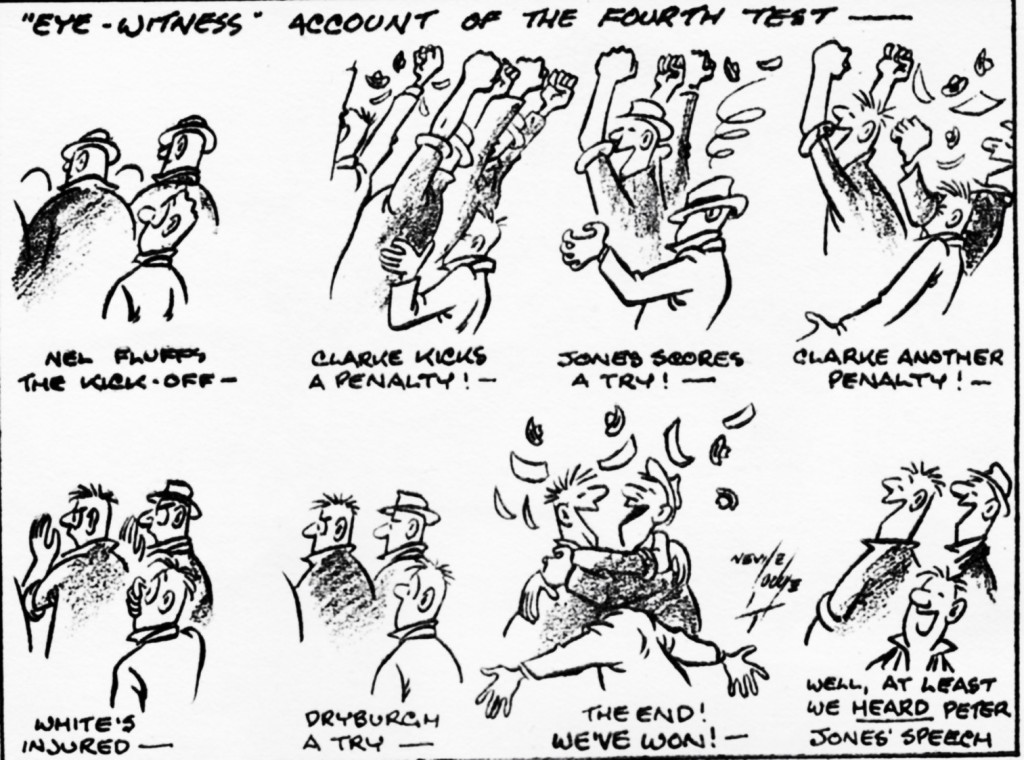
Contemporary accounts tells of huge touch-finding kicks, the aerial ping-pong battle between Clarke and Viviers, the to-and-fro of the game, the forward rushes the intense even wild marking and tackling resulting in messy play and missed opportunities.
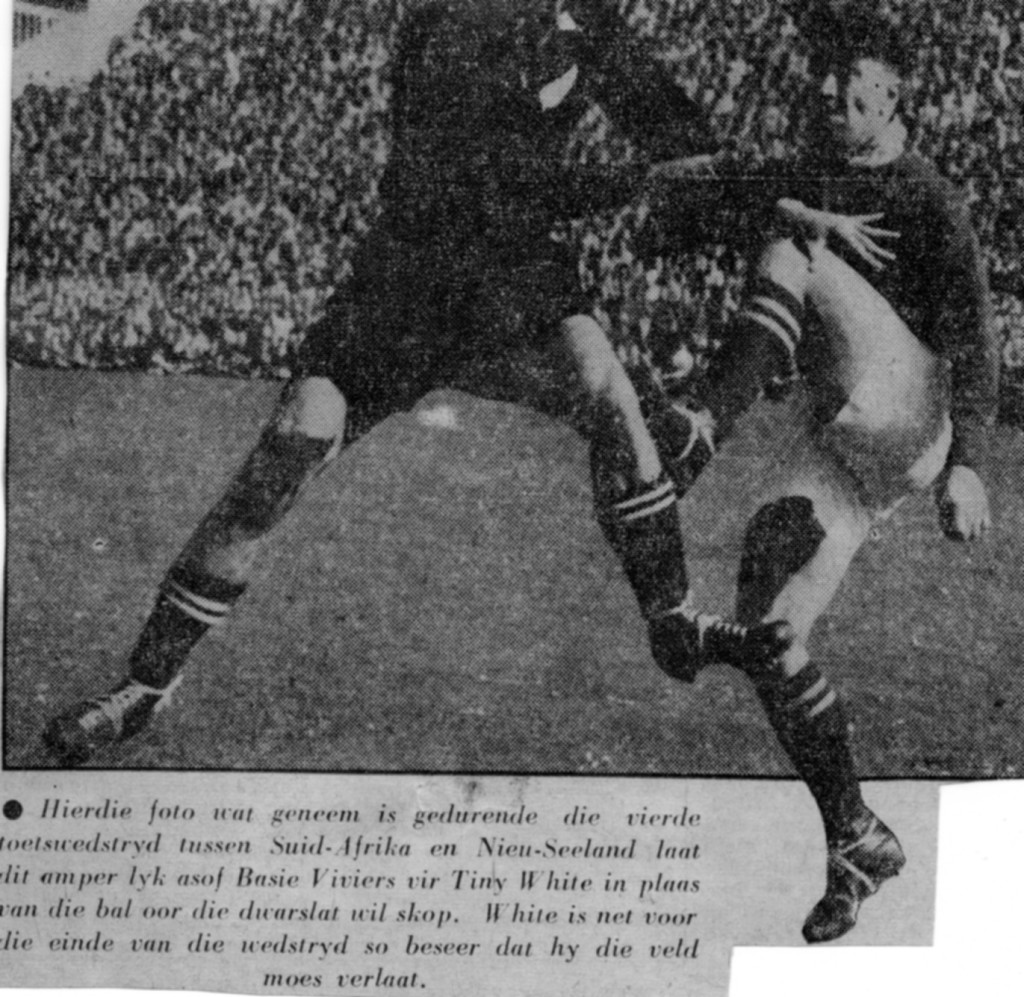
Right from the start there was an aerial battle royal between Viviers and Clarke. This picture shows Basie Viviers getting rid of the ball under pressure from Tine White in his own in-goal area
The All Blacks kicked the ball down field from the scrum which resulted from the fluffed kick-off by Nel. The Springboks absorbed the pressure and pushed play back into the New Zealand half forcing a penalty just outside the New Zealand 25 but wide out near the touch-line.
Viviers missed with the kick which could have made a huge impact on the morale of both teams.
The Springboks then dominated play for a while before New Zealand was awarded a penalty. Clarke narrowly missed with a 62-meter kick.
Jardon made a run but was dumped into touch by Briers.
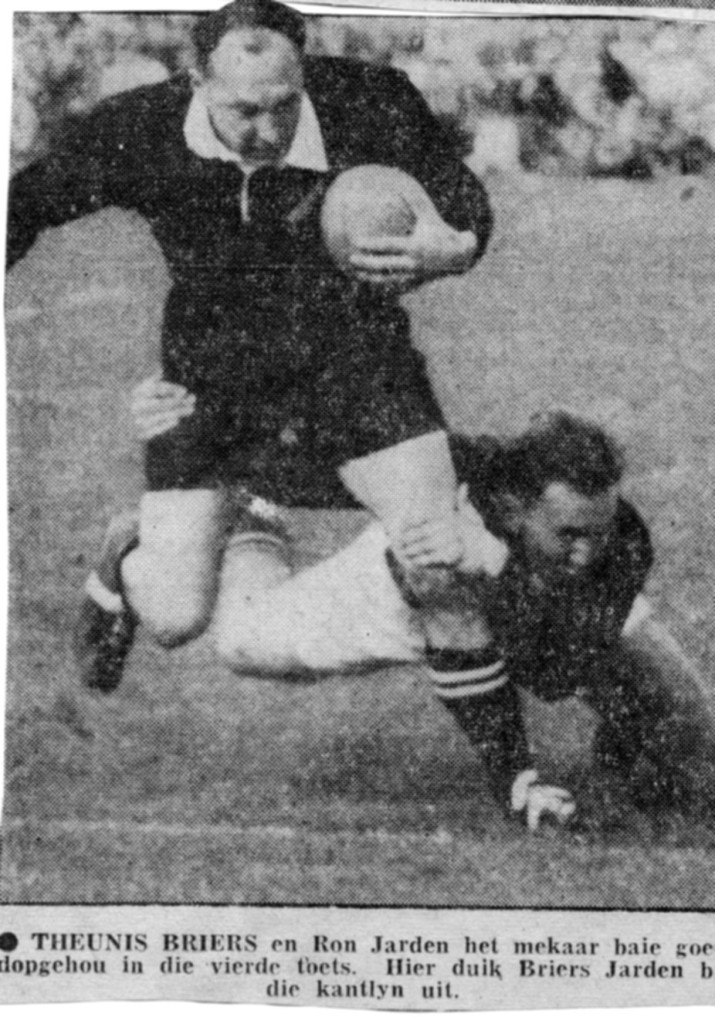
Jardon and Briers watched each other closely. Jardon injured his arm in the second half and went off for a while before returning as a second fullback
Clarke tried unsuccessfully to drop kick from the halfway line before he got his second penalty opportunity after 16 minutes of play. This kick from just inside the Springbok half and near the touchline soared straight through the upright for New Zealand to take the lead 3-0. There were unsuccessful penalty attempts by Viviers and Clarke while Dixon as well as Gray came close to scoring. The half time whistle went, however, with the Clarke’s penalty as the only points of the first half.

Clarke’s morale boosting long-range penalty in the first half
Jones scored his never-to-be-forgotten try five minutes after half time. The try resulted when Hemi and Jones busted through a ruck and swooped on Strydom. Hemi nudge the ball out of Strydom’s reach and set off dribbling down the sideline. He toed the ball in-field when the Springbok cross defence arrived. Peter Jones kicked it forward. Basie Viviers was there but failed to advance and smother the bouncing ball. The ball bounced about chest high and Peter Jones at full tilt took it almost out of the hands of Basie Viviers who did a perfect imitation of a matador stepping neatly inside to let the mass of muscle crash by him.
Retief and Dryburg chased him all the way but couldn’t catch-up.

Jones scoring the try that send New Zealand into frenzy
Clarke converted to take the score to 8-0.
Johnstone moved to flyhalf and made a couple of good breaks but was unable to get the ball to his wing.
A forward struggle broke apart and Skinner’s fist struck into Newton-Walker resulting in a penalty opportunity for Dryburg from 25 meters out; he missed it.
Clarke didn’t miss soon afterwards with another long-range penalty to take the score to 11-0.
In the 37th minute there was sudden flurry of blows between Skinner, Lochner, Bekker and I.J. Clarke. Tiny White was lying on the ground, brutally kicked and biting his finger to stifle the pain. Nobody was sure whose boot went in but the belief is that it was an attempt to get Skinner. ‘It was a frightening moment. White’s screaming could be heard above the noise and it looked like we were witnessing the making of a paraplegic right before our eyes’, wrote Warwick Roger in ‘Old Heroes’.
Fred Labuschagne wrote as follows about the last three minutes of the game: “Now the match becomes a mess. The Springboks seemed to go berserk and the forwards were hitting and kicking everything in sight which looked like an All Black. It was as if they suddenly realised that these were the final three minutes of the whole miserable tour and who the devil could discipline them now –or tell them not to hit back – or threaten them with a speedy return to South Africa for disobeying orders. It was not a pretty moment for rugby when Tine White was lead off in his final test for New Zealand.”

Things settled down after the White kicking incident and play resumed in a more orderly fashion.
In the dying minutes Briers took play into the New Zealand 25 with a good run. The All Blacks in person of Gray tried a counterattack and that resulted in a try for Dryburg. Viviers converted to make the final score 11-5.

Dryburg scoring his try right at the end of the game

This dramatic picture shows Danie Craven at the moment the final whistle went. It is hard to fathom Mrs Craven expression; is she smiling or is she amused?
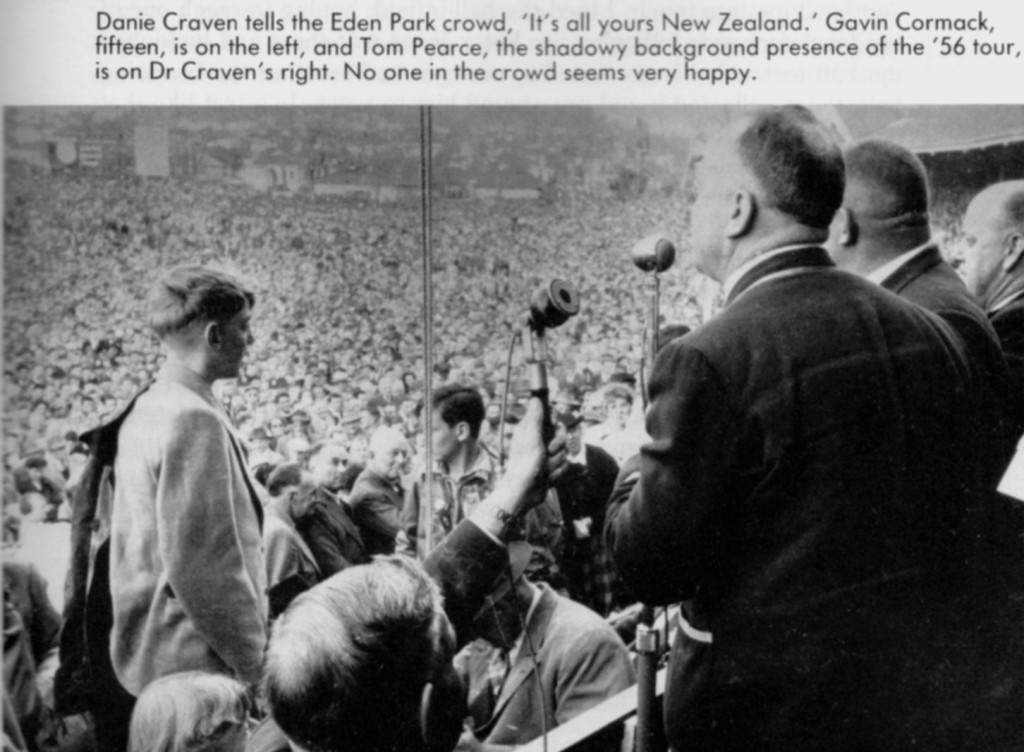
Danie Craven spoke to the crowd and said: “It’s all yours. May I extend to you our hearty congratulations on winning the rubber. We grant you this. We would have liked to win… but we have one consolation. You know how it feels… We have no regrets, no excuses.”
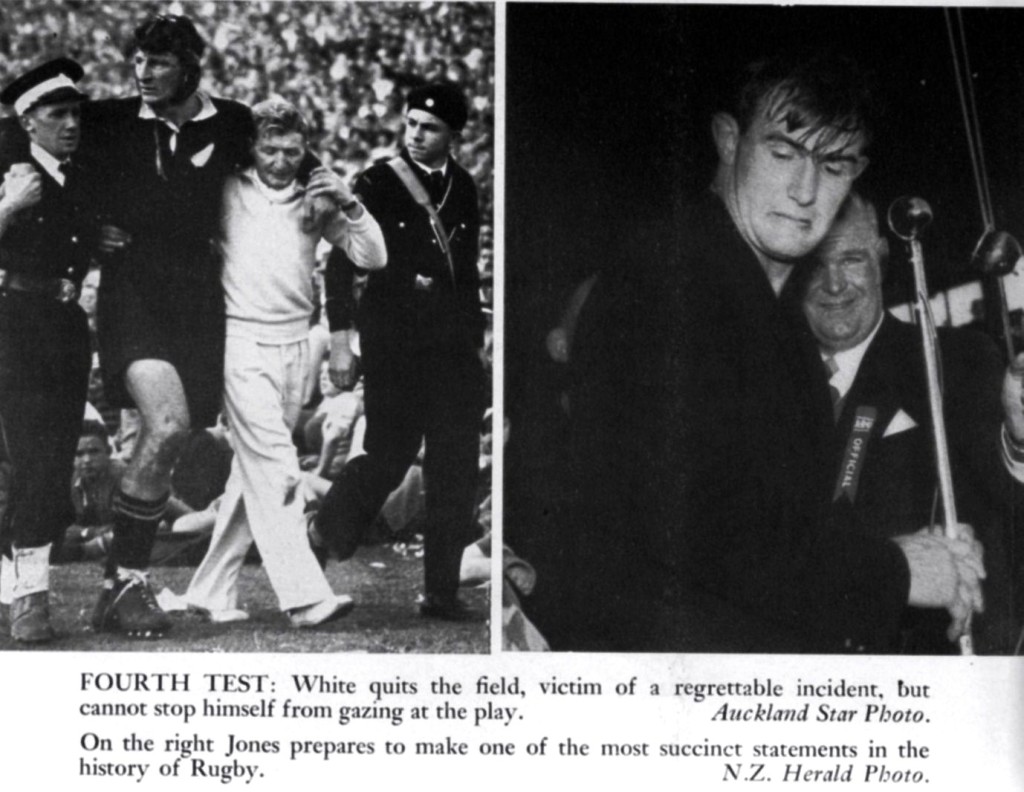
Peter Jones talked to the crowd and said: “I hope I have never to play a match as hard as this one. I’m absolutely buggered!”
Summary:
The match did not end on a particular happy note. At the final whistle thousands of spectators flooded to the playing area but the players did not approach each other or exchange jerseys. Don Clarke recalls that in the All Black dressing room there was an overwhelming feeling of sheer relief. One player said: “If I had to play under this strain for very much longer, I’d need psychiatric treatment.”
Some players reported that it took them three months just to sleep properly again.
Terry McLean summed the match up in the New Zealand Herald:
“The long, long trail has ended. New Zealand on Saturday entered the land of Rugby dreams by defeating South Africa in a series of test matches. The game satisfied most people. The want of attacking play by the All Blacks was offset by superb forward play and an exhibition by the North Auckland powerhouse, P.F. Jones, which will almost certainly become legendary. Springbok skill in the close-quarter forward play and in some elusive and swift running in the backs was countered by a wonderfully fiery and well-controlled All Black pack, tackling which would certainly rate A1 at Twickenham and a demonstration of fullback play, allied to goal kicking which made D.B. Clarke, of Waikato, another of the immortals of the match.
The game was fiercely fought and if the goal obtained by the Springboks in the very last minute of play was pretty pure luck it was at least a tribute to the distinction and determination with which the team fought for the honour of South Africa. Basically the difference between the two teams was one of tactics. Because of the inadequacies of the New Zealand backline, the All Black attack had three essentials – driving play (which, as personified by Jones, developed a tremendous quality) by the forwards, short punting by A.R. Reid, and short tactical punting, by R.H. Brown. Added to the superb goal kicking by D.B. Clarke, this essentially simple scheme of attack, diligently applied, frequently involved the Springboks in desperate defence. The Springboks won the admiration of all with their determination. When, at the last, all hope was lost, they still sought in some way or another to attack the enemy goal.”
GBS, the format has changed a bit. I can’t find the cut-line which provides you with only the first paragraph for the home page.
Hi McLook.
Where did you want to insert the read more line?
Hi McLook. I made the change after the first paragraph. Please check if this was the right spot. If not, I will just move it.
@ Timothy Bornman:
Sorry for the delayed response; was in town for a while.
Thanks for the insertion. First paragraph is fine.
Thanks McLook, great one, as usual!
Users Online
Total 385 users including 0 member, 385 guests, 0 bot online
Most users ever online were 3735, on 31 August 2022 @ 6:23 pm